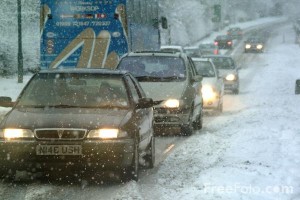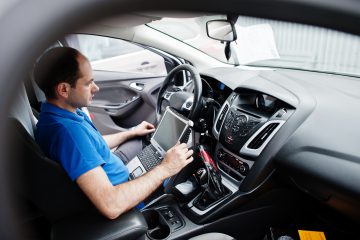 Winter has once again arrived in many parts of the world, and like it or not, it usually means greater odds of car trouble. Do you know that approximately 70% of motorists do not prepare their car for winter weather? Don’t be one of them!
Winter has once again arrived in many parts of the world, and like it or not, it usually means greater odds of car trouble. Do you know that approximately 70% of motorists do not prepare their car for winter weather? Don’t be one of them!
As they say, prevention is better than cure. A thoroughly-checked and prepared car is the best way to avoid slippery situations on snow-covered roads. It will also lengthen your car’s life, keep you safe through the difficult driving conditions and also let you save loads of money. Remember, it’s very easy to avoid accidents and other problems if you know what to check. So follow these tips to make your car well-equipped to conquer whatever winter throws your way.
1. Check your battery and electrical systems
- Cold weather forces the car battery to perform much harder—just imagine the higher power demands of the heating system, defrosters, windshield wipers and lights (due to shorter daylight), etc.
- Do a quick and simple battery test: run your headlights before starting the engine, and if the headlights get brighter once you start the engine, you might need to perform additional tests. To do this, you can use a voltmeter to measure metering voltage, or check electrolyte levels. If your car is more than three years old, you might want to bring it to your nearest certified repair shop for a more thorough checking.
- Also, make sure that there is no corrosion in any of the battery’s posts and connections, and that it has enough water to run smoothly.
2. Check your oil
- The lower temperature affects the oil causing it to have thicker viscosity. If the oil is thicker, it cannot properly lubricate the engine and may cause problems during cold start situations. So as the weather gets colder, it is best to change into a thinner grade oil. There is no standard type of oil for all vehicles, so make sure to use the one recommended by your vehicle’s manufacturer.
- So if you are nearing a 30,000-mile full service, don’t delay and have an oil change (including oil filter change) immediately. A clean, high-quality and correct engine oil will make your car start and run smoothly during winter.
3. Inspect your belts and hoses
- Even if you are driving a relatively new and modern car, it is best to check the belts and hoses for possible wear and tear, as they can be easily affected by colder weather. Be meticulous in looking for cracked, worn-out or frayed rubber, because they just would not survive the cold, especially if there are often quick and extreme temperature changes.
4. Check your antifreeze mixture
- Antifreeze testers are cheap means of ensuring that your coolant system will run as it should. Make sure to conduct the test when your engine is cold to properly check the freeze point. If the mixture is off, flush and drain your cooling system and start a refill from scratch.
- In most cases, the recommended combination is 50/50 ratio of water and antifreeze coolant. This mixture will help prevent freezing even at extremely cold temperatures.
5. Replace wiper blades for maximum visibility
- Winter comes with shorter periods of daylight and snowfalls that reduce the driver’s vision, and since visibility is the primary key to safety, it is essential to make sure that the windshield wiper blades as well as the winter washer fluid are both in top condition.
- Although most windshields are geared for all-season use, excessive snow, ice build-up, road salt and slush can severely affect its performance. So, carefully check for a clean wipe on your windshield and enough amount of washer fluid (also note that ordinary washer fluid may have the tendency to freeze and become useless, so consider changing to winter washer fluid with de-icer and rain-X treatment). You may also choose to temporarily change to special winter wipers to have maximum visibility and security.
- Replacing your wipers and washer fluids are easy! You can do them by yourself if you know the correct blade size as recommended by your car manufacturer.
6. Check your tires
- During winter, most motorists stick to all-season tires, and swear they work just fine; that is, until they meet an accident! As it gets colder, the tire’s air pressure drops, and loss of air pressure also means loss of traction. So with all the snow, ice and road grime, it is much easier to skid and lose control.
- To avoid this, switch to winter tires! They are specially made to shed snow and ice more quickly, giving the driver more traction and safety. In fact, some car manufacturers specifically advise the owners to switch to winter tires during this season.
7. Check all your lights
- Visually inspect to make sure that all your headlights, brake lights, turning lights, fog lamps, flashers and any other lights are working properly. If they don’t work, they might just need a new fuse or a new bulb.
8. Protect your paint
- Snow, ice, road salt, or other chemicals on the road can damage your car’s paint. You can protect your car by applying an ample coating of high quality wax, preferably just before winter.
9. Clean and care for your car’s interior
- Although it is the car’s exterior that takes most of the beating during winter, you should not forget to look after the interior parts. Before vacuuming the floor and seats, make sure no big pieces of garbage remain. After vacuuming, you can use an upholstery cleaner to keep everything spotless and in tip-top shape. And because of all the snow and possible mud that your shoes might bring into your car, it is recommended to switch the carpeted floor mats into rubber mats or water-resistant vinyl mats. Then, you can finish everything with your favorite air freshener to add that special touch.
10. Keep an emergency kit handy
- Remember that even if you have done everything to keep your car in top-notch state, there is still a chance to encounter unfortunate and unexpected situations. So, for whatever season, above all during winter, it is necessary to keep an emergency kit on your trunk, especially if you will be having long drives.
- For winter, here are the recommended emergency kit items:
i. First-aid kit (with medicine and other injury remedies)
ii. Car tool kit
iii. Flashlight with working batteries
iv. Blanket, extra socks, gloves and hat (to keep you warm)
v. Emergency food and water (if you get stuck in major traffic)
vi. Ice scraper and snowbrush (with soft bristles to avoid damage)
vii. Portable shovel and road salt
viii. Spare tire and tire changing equipment
ix. Flares
x. Well-charged mobile phone with power charger
I hope that with these tips, you can protect yourself and your car from any unwanted winter accidents. Don’t be one of those careless motorists who regret lacking preparation when it’s too late. Fortunately, many of the parts you need are easily available online and can be delivered quickly right at your doorstep! Check http://www.autopartsway.com/ for more details. Keep safe and enjoy the winter!



